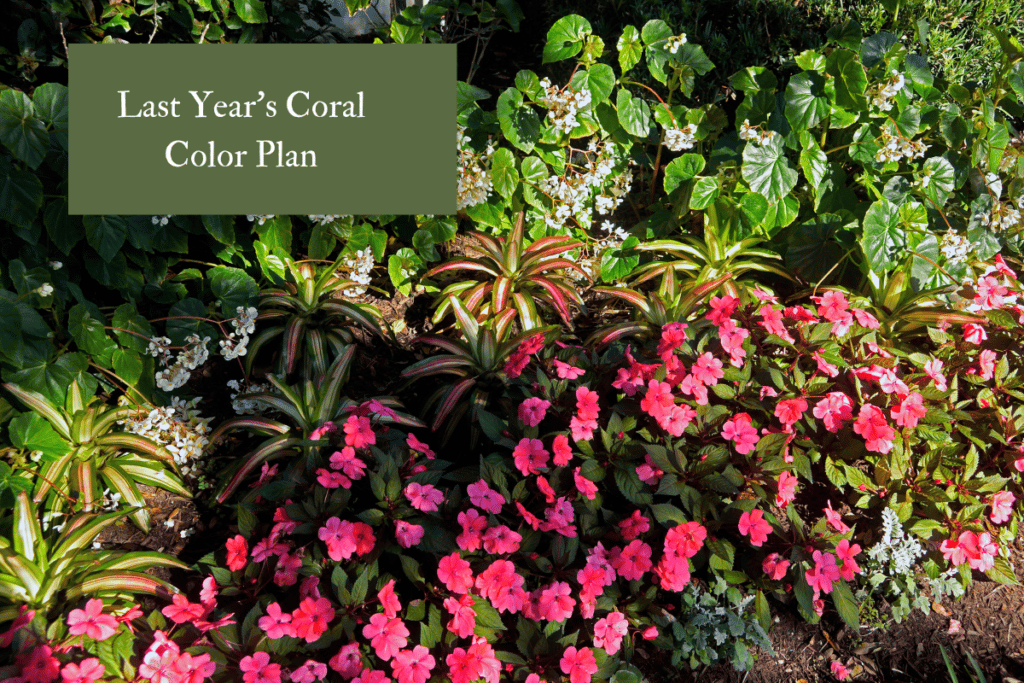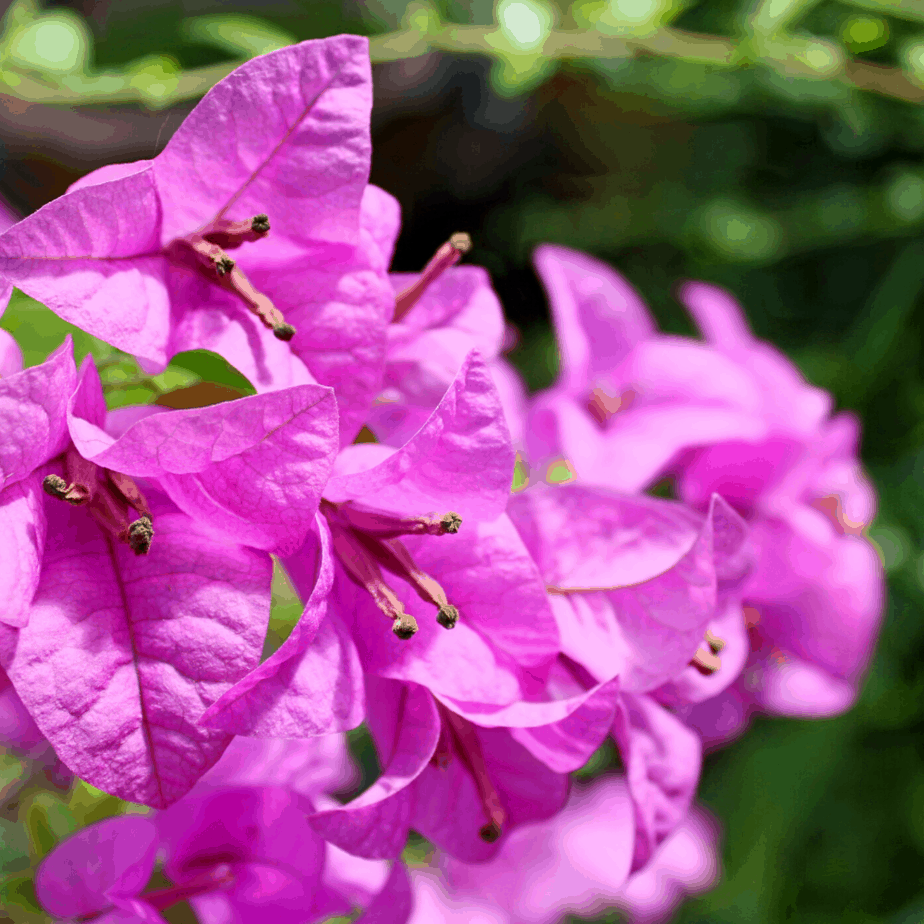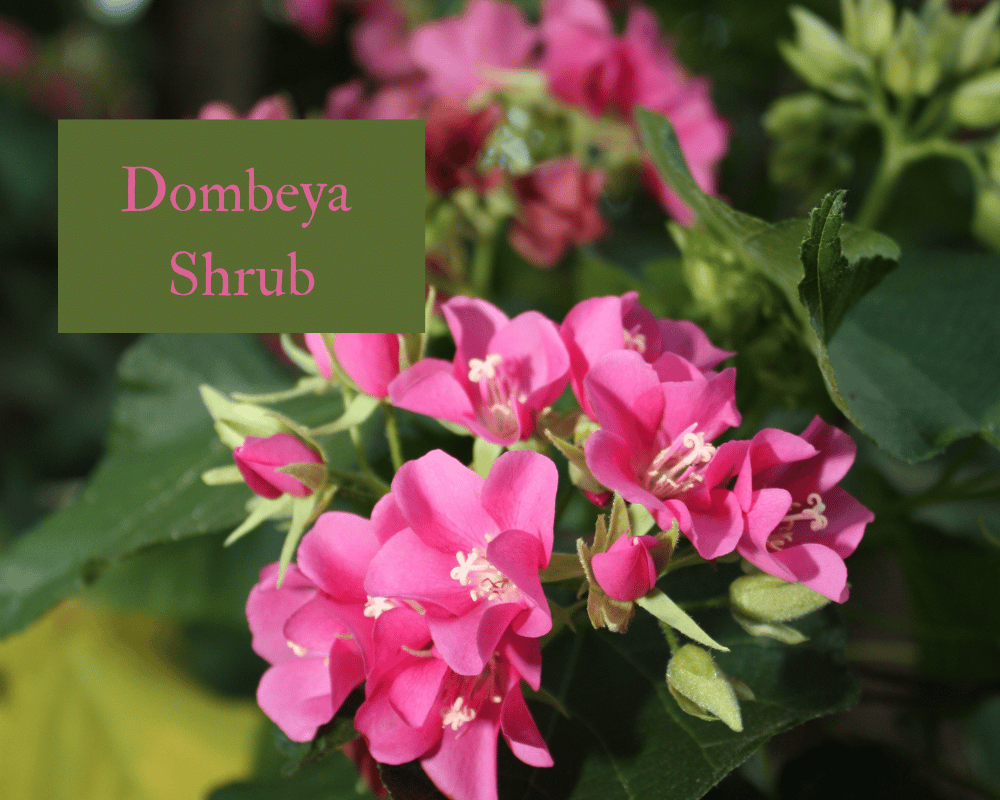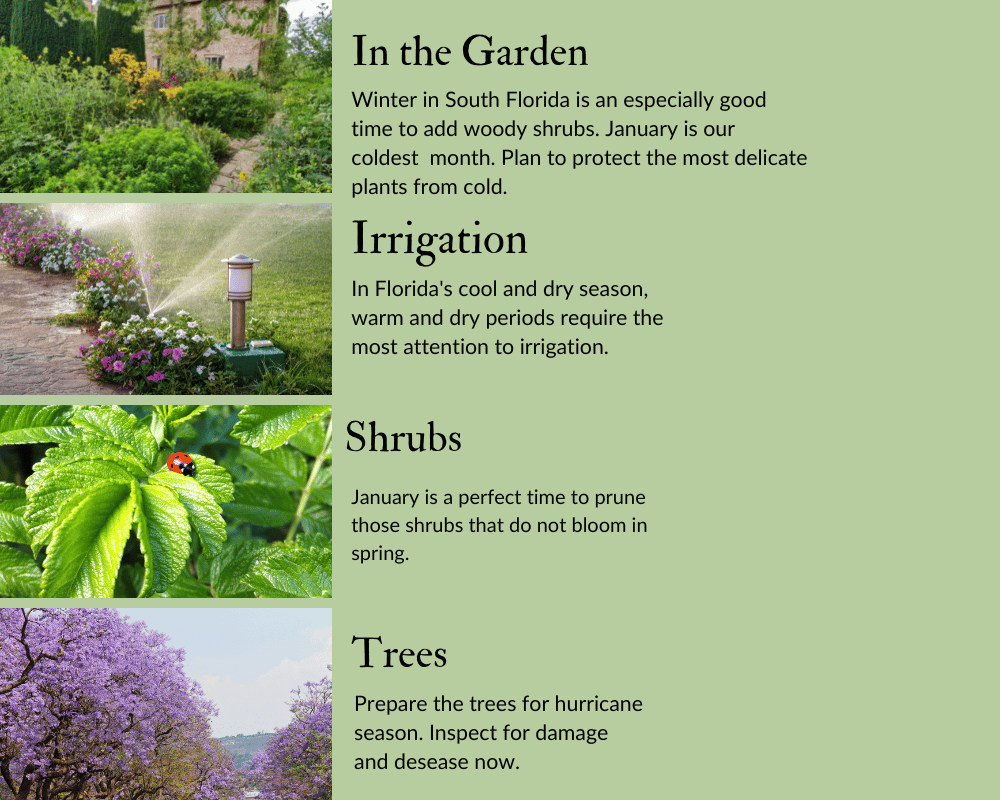This Month: What’s In Bloom, What To Plant, See And Do!
Gardening In Florida
It’s January and like all gardeners, we learn to live with our climate. South Florida shares its tropical climate with the Caribbean and places in Southeast Asia. We are North American gardeners and the climate we garden in now has little in common with the rest of North America and with our former gardens! If you are adjusting to a Florida garden, keep this in mind and you will be miles ahead!
Gardening In January (2024)-Authority, Prosperity, Good Fortune

Florida gardens are in bloom for 12 months per year, a remarkable pleasure. But what grows each month is distinctly different. In our Florida gardens, we learn to adjust our plans to two seasons each year; (not four!) mild and dry winters; with hot and rainy summers. Further, January is the middle of the cool season and the best time for gardening!
January, Prime Time In The South Florida Garden
In addition, a large part of what grows in North American summers grows for us between October and May. Most vegetables are thriving. We live in a town near important producers of winter fruit and vegetables. We eat fresh local tomatoes in winter, then Georgia-grown in late spring, followed by Tennessee produce, and on to New Jersey and back around to home-grown in winter.
Our January garden is robust, but we grow no lettuce in the hot summer. Our midsummer salads are northern grown and we have learned to like them. Our farmers’ markets and restaurants offer fresh produce from small local organic farms, but not in summer.
What’s Happening This January In The South Florida Garden

A lavender hedge of Philippine Violet should be reaching maturity, we’ll add to the littoral shelf plantings at the pond edge and increase the orchid collection. The ground cover added in the newish backyard seating area is in its ‘leaping’ year and the jasmine archways are maturing.
It’s time for a new idea for our small garden!
The Gardener’s Horiscope
2024 is the year of the Wood Dragon in the Chinese Horoscope, and it promises us authority, prosperity, and good fortune. What gardener would turn down such an offer?
January In The Garden-Temperature And Rainfall
Our South Florida Garden-Temperature And Precipitation

Weather is a critical element in a gardener’s life. It dictates everything we do. No matter where our gardens are we all need to know, and live by the same things:
For gardeners in our plant hardiness zone, we can expect mild temperatures and little rain. If you check the newest USDA plant hardiness zone map you will notice that we can get a temperature as low as 30 degrees F. which may require protection for the tropical plantings.

- Our plant hardiness zones
This will take you to the newest version of the USDA Plant Hardiness Zone Map
Here is some help in translating the map to your needs.
Also, this is the version for Florida. You can find a map for your state and search for small areas by zip code.
- Heat Zones-How hot can it get in your garden, can your plants take the heat?
- Our Garden’s Microclimates your garden’s microclimates and plant to enhance them.
‘Microclimates: Identify, Evaluate, Influence and Use Them’
‘How To Determine Your Garden’s Microclimates’ Washington State University Extension Service’
What Blooms In January
First, avoid the dangerous myth that Florida has no seasons. It is a common but dangerous misperception. Change is subtle in a tropical climate, it takes time to notice the distinctions but like any garden, anywhere, change is always with us and it affects what we grow.
Annual Blooms

If you are or have been a temperate climate gardener, all of the plants you loved in summer are thriving today in our Florida gardens.
Beds and containers of annuals allow us to change the color scheme every season.
Bougainvillea (Bougainvillea)

If you have a place with at least 6 hours of sun and superior drainage, in zones 10-11, and you have a place for a shrub, vine, or tree, the brilliant colors of bougainvillea will work for you.
The flowers are the tiny blooms inside, what we admire (the bright pink parts) are bracts, a modified leaf. Like the poinsettia, the bougainvillea is a plant in which the modified leaf is the attraction, not the tiny flowers.
Dombeya (Dombeya wallichii)

Also called tropical hydrangea, this large shrub is perfect if you can use privacy, and brilliant blooms throughout the cool season in zones 9-11. (You can also grow it in containers.) It is remarkably low maintenance, you will prune it, and it is happy in full and partial sun.
If you have not seen this plant, you will, as it is growing in popularity.
Powderpuff Shrub (Calliandra haematocephala)

Powderpuff blooms as a shrub in our front yard and brings us a daily supply of butterflies, hummingbirds, and bees. You can find a dwarf variety, a larger shrub, and a tree. They live in full to partial sun, and in their zones, 9b and warmer are very cold resistant. As January is normally our coldest month this is one pretty plant we don’t think about in what passes for cold weather in our garden.
What To See In January

Visit the Kampong, formerly the home of plant hunter David Fairchild near Biscayne Bay in Miami. Dedicated to the development of tropical plants it is home to the International Center for Tropical Botany.
Here is how to find the garden: The Kampong,
What To Plant In January
January should be our coldest month, making it time to plant cold hardy plants suitable for our climate. It is not too late to add cool-season annuals, including flowers, vegetables, and herbs.

Annual Blooms

In January we like to add the cold climate annuals to those we planted in early fall. True cold climate annuals such as pansies and snapdragons have short life spans in our mild winters. If you like them, now is the chance to use them. Also, try lobelia for a true blue color for your garden and the silver color or dusty miller, these two will last until spring.
Summer Blooming Bulbs

Plant many of the summer-blooming bulbs starting this month. (Caladiums will be shipped starting in March to gardeners in South Florida and to points north as the spring progresses.)
Try these:
Herbs

Grow any flavorful herbs you choose, all will perform in our cool-season gardens. If you want to grow delicate plants that do not accept our humid summers now is the time to grow them. These include chervil, cilantro, and dill.
Vegetables

The list of winter vegetables is long. The best source of information for Florida vegetables is the University of Florida’s extensive research.
Florida Vegetable Gardening Guide

We will add some herbs in containers and when summer’s intense sun and driving rains appear we can move them to shelter and extend their useful season.
Gardeners are planners and part of the challenge is considering future conditions.
What To Do In January

In The Garden This January-Plant Woody Shrubs
Plant trees and woody shrubs this month, they are dormant and will devote energy to growing roots and will require less water. The plants will be well established when hot weather arrives.
Irrigation In January
Our South Florida lawns have slowed their growth, but are not dormant, water as needed. Water young shrubs and trees until established. Water in the early morning whenever possible. and use a rain gauge to keep track of moisture. In 2023 our rainfall was below average, using a rain gauge will keep track of moisture.
Prune Shrubs
Prune only those shrubs that do not bloom in spring and begin to prune trees to prepare for hurricane season. Pruning now will allow the plants to grow dense by spring. Also in January, it is easier to see the branching structure and there are fewer pests active at this time making the new cuttings less likely to be damaged.
Trees-Starting Hurricane Preparation
In January, South Florida is halfway to hurricane season, it is time to look for damage and structural problems and prepare the trees and shrubs for storms.
Extending The Life Of Christmas Bulbs And Plants
Poinsettia
- Ensure the plant has 6-8 hours of bright indirect light.
- In April prune the branches to about 6 inches in length, and fertilize after growth begins.
- The plant can be outdoors in warm weather, starting in partial shade and moving to sun.
- In September you can bring the plant indoors and repot if growth requires it.
- Beginning in October, ensure that the plant has 14 hours of darkness per day to rebloom.
- Can I leave them outdoors in Florida? Yes, however, the plants will grow very large in the ground and must have a completely dark nighttime to rebloom.
Amaryllis
Do not toss that spent amaryllis bulb! The plants are magnificent, the bulbs are pricey and if handled correctly will last for you for 75 years! Amaryllis are like peonies, you may well leave them in your will!
‘How to Collect And Cultivate Amaryllis.‘
Christmas Cactus
Christmas cactus will last for you and rebloom, you can also propagate by cuttings. They prefer to be potted (and rarely repotted) in a humid location in bright, indirect sun. These are ‘short day’ blooming plants which means long periods of uninterrupted darkness for six weeks at night.
Summary, January In The South Florida Garden
‘No one ever regarded the first of January with indifference.’
-Charles Lamb
Each month in the garden is prime time for some beauty to enjoy, some plants to add, and some tasks to perform. January tends to be our coldest month and is in the exact middle of our cool season. Most of what grows well this month should last until the end of May. Plant and grow any of our cool season categories and enjoy the cool season blooms.
Our mild winters are also the best time to do the heavy work in the garden. We do any major projects we can in this season leaving summer for maintenance.
References You Can Use
Florida Gardening Calendar– from UF, by region, and by month.
Gardening with Annuals in Florida– note the valuable charts showing annual varieties and what months to grow them.
